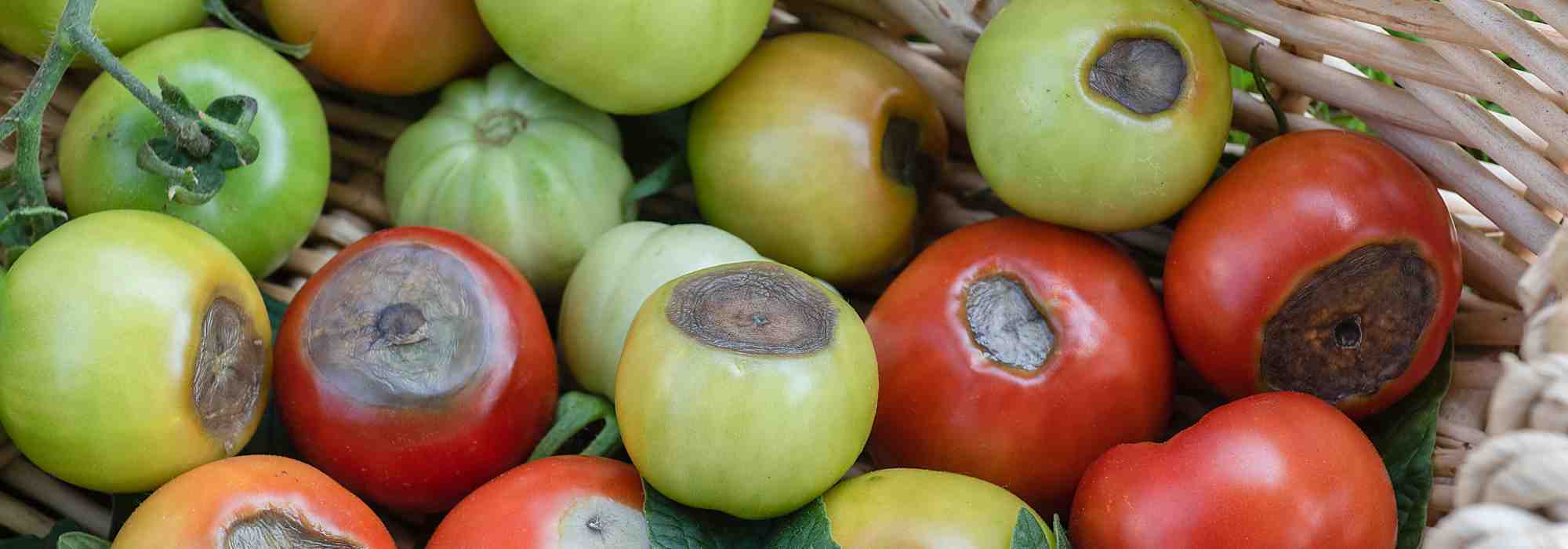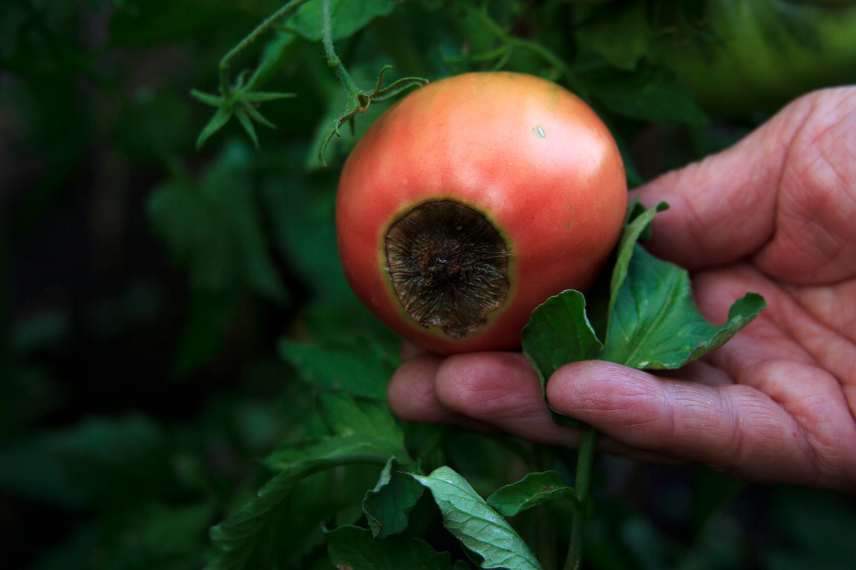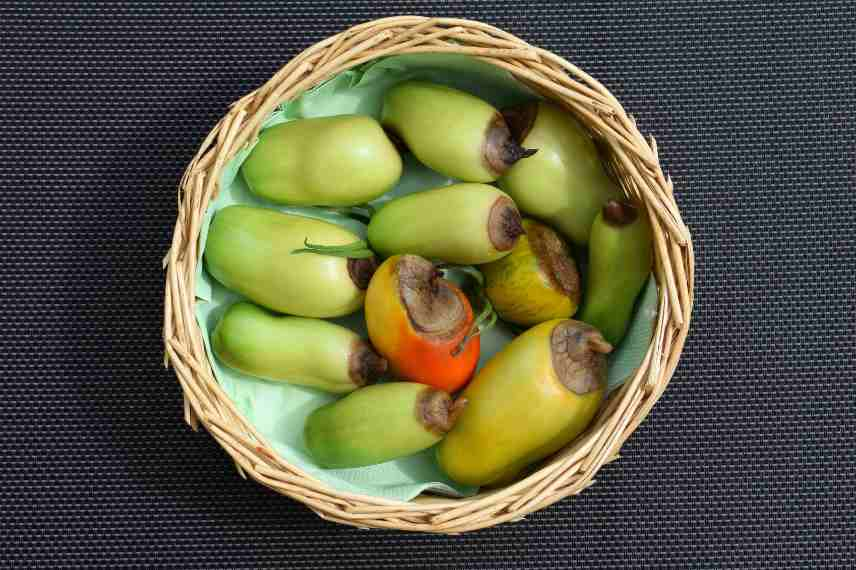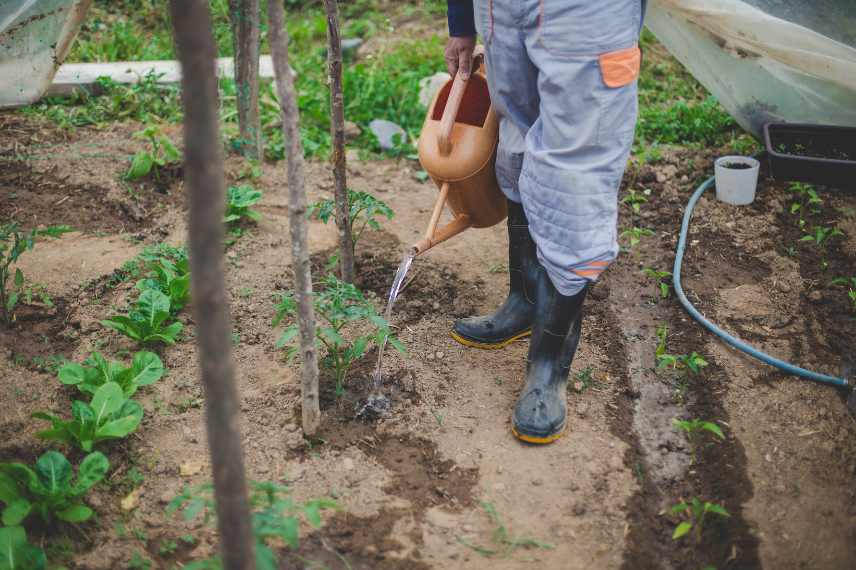
Black bottom of tomatoes: how to fight it effectively?
Prevention and Control Tips for Tomato Blossom End Rot
Contents
What gardener hasn’t discovered, one morning during their vegetable patch rounds, some of their tomatoes—still green or nearly ripe—marked with a black spot or lesion at the base? Highly characteristic, these spots are the main symptom of a physiological issue commonly known as blossom end rot in tomatoes. It is actually a form of apical necrosis or rot, quite common in vegetable gardens, but far from irreversible.
Discover how to identify this apical necrosis in tomatoes, understand its causes to better prevent it, and take effective action.
What is apical necrosis or blossom end rot in tomatoes?
First and foremost, it’s important to clarify that apical necrosis, commonly known as blossom end rot in tomatoes, is not a disease but rather a physiological disorder caused by a deficiency. Specifically, a calcium deficiency. So, in practical terms, a fruit affected by blossom end rot is a fruit lacking calcium. In fact, fruits showing signs of blossom end rot are not properly absorbing the calcium present in the soil that they need for development.
As the name suggests, this physiological disorder develops on the apical part of the fruit, meaning the opposite end to the peduncle. In cruder terms, at the “bottom” of tomatoes (but also peppers or, more rarely, squashes). This condition appears when tomatoes are in full development, affecting both green fruits and those in the process of ripening. A dark, rather brown spot forms at the base of the tomato. It grows to become black and dry. It can cover nearly half of the fruit, which remains edible once the affected part is removed. This spot also serves as an entry point for other organisms. Naturally, the harvest is impacted and devalued.

Apical necrosis affects green tomatoes or those in the process of ripening
Apical necrosis tends to affect more elongated tomato varieties, such as the ‘Cornue des Andes’ and similar varieties (‘Cornabel F1’, the ‘Roma’ and its hybrids like ‘Colibri F1’, the ‘San Marzano’. On the other hand, round and generously sized tomatoes like the ‘Cœur de Bœuf’, the ‘Saint-Pierre’, the ‘Buffalo Steak F1’ …are significantly less susceptible.
What causes blossom end rot?
It is therefore a calcium deficiency that causes blossom end rot in tomatoes. But, contrary to popular belief, it is a localised deficiency in the fruit, not in the soil. Indeed, soils are very rarely devoid of calcium. In reality, calcium may be present in sufficient quantities but poorly transported or assimilated. Calcium is transported within the plant through transpiration. However, the leaves, which are very active in this regard, are favoured over the fruits, which then receive less calcium. If the plant experiences water stress, overly rapid growth, or a nutritional imbalance, calcium distribution can be disrupted.

Elongated tomatoes are often more affected than other varieties
This is why blossom end rot in tomatoes can have several triggering factors:
- Irregular watering, rather than excessive or insufficient watering. This lack of consistency in watering causes water stress in the young tomato plant
- Overly rapid growth, often due to excess nitrogen (for example caused by mulching composed solely of grass clippings)
- A weak root system due to overly compacted and dense soil, poor drainage, or sudden temperature changes
- Overly salty soils due to excessive chemical fertilisers and salty or overly hard irrigation water (less common)
What to do if blossom end rot appears?
Don’t panic if some of your tomatoes are affected by blossom end rot. Adopting simple measures will help limit the damage and ensure a good harvest. However, affected fruits are not or only partially salvageable.
To effectively combat blossom end rot, you must act as quickly as possible. First, **remove the affected tomatoes**, as they can hinder the development of others. This way, the plant will focus all its energy on healthy fruits.
Next, **the most crucial step is maintaining a metronome-like regularity in watering**. This is the key to success! Of course, you’ll have to account for unpredictable weather if your tomatoes are grown outdoors without shelter. However, it’s easier if you grow them in a greenhouse or under cover. You might say it’s hard to estimate watering frequency—and you’d be absolutely right, as watering depends directly on soil type and ambient heat. Still, remember that **it’s better to give a substantial watering (about 5 litres of water per young plant) every three to four days in free-draining soil, or every five to seven days in heavier soil, rather than small daily waterings**. Roughly speaking, a regular weekly watering (reduced to every five days in hot weather) is ideal for healthy tomatoes. This encourages deep root system development, allowing them to access the calcium they need.
To maintain good moisture levels and reduce water stress, **it’s recommended to mulch around the base of tomato plants with straw, dead leaves, or [BRF](https://www.promessedefleurs.com/conseil-plantes-jardin/ficheconseil/le-brf-ou-bois-rameal-fragmente-quest-ce-que-cest-comment-lutiliser-au-jardin/)**, which is lower in nitrogen than grass clippings.

Very regular watering prevents blossom end rot in tomatoes
If consistent watering hasn’t resolved the issue, **you can also enrich the soil with a calcium-rich amendment**. A good compost application may suffice, but you can also add [wood ash](https://www.promessedefleurs.com/conseil-plantes-jardin/ficheconseil/comment-utiliser-la-cendre-de-bois-au-jardin/) (sparingly), [bone meal fertiliser](https://www.promessedefleurs.com/engrais-et-fertilisants/amendements/corne-sang-engrais-specifiques/poudre-d-os-dcm-u-a-b-riche-en-phosphore-differents-conditionnement-disponibles.html), or Patentkali. However, forget about crushed [eggshells](https://www.promessedefleurs.com/conseil-plantes-jardin/ficheconseil/coquilles-oeufs-jardin/) or oyster shells—they take far too long to break down to be effective. In any case, properly organic-rich soil won’t need additional amendments.
Once again, **consistent watering is the primary treatment for tomato blossom end rot**. Sheltering them also helps better control water supply, independent of weather conditions.
How to prevent apical necrosis?
The best way to prevent blossom-end rot is through prevention. By adopting appropriate cultivation practices, tomato blossom-end rot will soon be a thing of the past:
- Regular watering management: water deeply rather than superficially, regularly and moderately, avoiding sudden fluctuations. Mulching complements this approach.
- Soil amendment with well-rotted compost or manure improves structure and water retention.
- Avoiding any stress (refrain from excessive leaf removal or strict pruning).
- Choosing resistant varieties. As mentioned earlier, elongated tomatoes are more susceptible, so opt for round varieties if you struggle with watering management.
- Subscribe!
- Contents































Comments